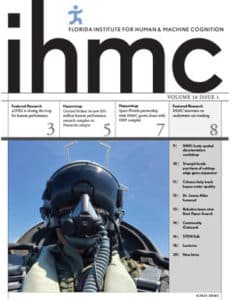STEM-Talk: Don Layman on the role of dietary protein in muscle, health, and disease
Few people know more about muscle development than Dr. Donald Layman.
As the world’s foremost authority on dietary protein and amino acids, he is known for his extensive research on muscle development and his studies of metabolic regulation for obesity, diabetes, and cardiovascular disease.
Layman’s interview with STEM-Talk co-hosts Drs. Ken Ford and Marcas Bamman is now available on IHMC’s website and YouTube as well as in popular podcast apps.
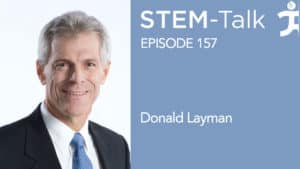
Dr. Donald Layman is an expert on muscle, health, and disease.
“I think everyone knows that our body has a lot of protein in it,” Layman says. “What people don’t realize is we have a constant process of turnover. Every protein in the body has a half-life. Some last an hour or two, some last 30 or 40 days. We have this constant rate of repair and replacement going on. That’s why we need to pay attention to protein turnover. How well we do this process of protein turnover has a lot to do with long term health and aging.”
Layman spent 31 years on the faculty at the University of Illinois Urbana-Champaign, where he is now a professor emeritus. His lab focused on understanding how metabolism works.
Today, he works as Director of Research for the American Egg Board and is a nutrition consultant for the National Dairy Council and The National Cattlemen’s Beef Association. He also is the Chief Science Officer for Qivana, a natural products marketing company that promotes the weight-loss program that Don developed at Illinois.
Our conversation includes:
- How Layman’s small-town childhood fueled his curiosity. “Growing up on a farm makes you curious, makes you wonder how to make things work,” he says. “I was always interested in why things worked, the math and science of it.”
- How life on the farm influenced him. “As a small-town boy whose horizons weren’t that broad, I was willing to go with the flow and figure things out.”
- Discoveries in the late 90s that the showed how important protein is to countering the effects of aging.
- The right amount of protein an individual should consume and mentions that there is much confusion on this issue, largely due to the food pyramid’s recommended daily allowance for protein of 0.8 grams per kilogram of body weight.
- The protein deficit that women experience. Don says 40 percent of women who are 60 and older consume less than the RDA for protein, which is likely the bare minimum. And among women between 16-22, only 20 percent consume the minimum RDA.
- The challenge that vegans face in getting the right amount of protein compared to carnivores and omnivores, largely because the amino acid leucine, which is vital for muscle repair and replacement, and is very low in plant-based foods.
- His 2005 paper titled “Dietary Protein and Exercise Have Additive Effects on Body Composition,” which demonstrated the synergy of protein and exercise.
- What sort of exercise should people do to build muscle after correcting their protein intake.
- The optimal amount of protein people should consume at breakfast and throughout the rest of the day.
And much more.
Fall Evening Lecture Series kicks off with expert in autonomous ocean robotics
Nic Radford wants us to love ocean exploration the way we romanticize space exploration.
He knows whereof he speaks. Radford is an engineer, roboticist, inventor, and entrepreneur who spent 14 years at Lyndon B. Johnson Space Center’s Dexterous Robotics Laboratory at NASA in Houston. He now is founder, president, and CEO of Nauticus Robotics Inc., a company that creates and deploys autonomous marine robotic systems.
He launched the Fall 2023 Evening Lecture season at the Florida Institute for Human and Machine Cognition (IHMC) with the talk, “From Outer Space to Inner Space: Developing Robots for Final Frontiers,” on Sept. 20. You can watch the lecture here if you missed it in person.
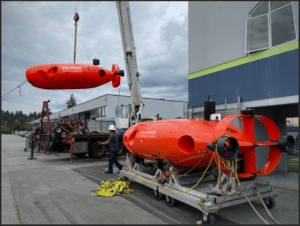
One of Nauticus Robotics’ autonomous marine robotic devices. Nauticus founder and CEO Nic Radford opens the Fall 2023 IHMC Evening Lecture season.
“Space flight dominates our romantic thinking,” Radford said. “I’d like to see us explore Mars, but there are lot of pressing challenges here on Earth and those pressing challenges could use investment.”
Radford calls Nauticus his life’s work and says it directly ties to his 14 years at NASA. Applying technological principles his team learned from spaceflight robotics, Nauticus challenges the aging and inefficient existing service infrastructure of the offshore industries, Radford says.
“The ocean is fundamental to almost every aspect of human life but is rarely top of mind for people and research for it is vastly underfunded,” he says.
He was the principal investigator leading the development of Valkyrie for participation in the 2013 DARPA Robotics Challenge and NASA’s future Mars robotics missions. At NASA, he received NASA’s Outstanding Leadership Medal.
He hopes that the Lecture audience comes away with a deeper understanding of how the investment we have made in space and space flight can translate into the realm that dominates the planet we call home.
“Nauticus is making strides for ocean exploration and methods for cleaner energy production while challenging status quo methods,” he said.
Space investment outpaces ocean investment by 100 times, but as Radford notes, “ocean space is 20 times more valuable” as an immediate economic and social resource to our species.
The ocean, Radford notes, is a huge economic engine for humanity. The clothes we wear, the food we eat, even the day-to-day transfer of information and energy all are tied to the ocean. Radford believes it’s time to give this vital space its due.
“The resources we all use every day are connected to the ocean,” he said.
The remainder of the Fall season of the Lecture series will feature experts in pavement design, robotics, planetary science, and more. Visit https://www.ihmc.us/life/evening_lectures/pensacola-lecture-series/ to stay up to date.
UPCOMING:
Dr. Stephen Anton
Anton has spent his career looking at the influence of lifestyle on healthy aging and chronic diseases including obesity, cardiovascular disease, and metabolic syndrome. His October lecture focuses on the importance of stress and recovery in healthy aging. Anton has previously been a featured guest on IHMC’s podcast, STEM-Talk, highlighting how eating and exercise behaviors can influence obesity, cardiovascular and metabolic conditions. A UF alumnus, he is currently a professor in the department of physiology and aging at the University of Florida. Watch his talk here.
Dr. Jeff Phillips
Phillips is a Senior Research Scientist at IHMC who develops mitigation strategies for common environmental, physiological, and cognitive stressors that break down optimal performance in military operators. Prior to joining IHMC, he spent six years as a research psychologist at the Naval Medical Research Unit in Dayton, Ohio. He worked almost exclusively on hypoxia in tactical aviation and served on a team that was instrumental in getting the F-22 Raptors back in operation. The Navy recognized his contributions to the F-22 project with the 2012 Delores M. Etter Top Scientists and Engineers in the Navy award.
Dallas Little
Little’s research interests include asphalt technology, pavement design, soil stabilization, fracture mechanics, soil mechanics and foundation engineering. He has served as principal investigator on more than $35 million in research in his academic career. He is a distinguished member of the American Society of Civil Engineers. Little has published more than 230 refereed journal publications, over 80 refereed proceedings, has contributed five books and has given more than 420 invited lectures.
Ocala lectures will include:
Sept. 28: Dr. Alexander Fleming: In his Pensacola lecture earlier this year, Fleming spoke about aging. People are living longer, but also are suffering with multiple chronic diseases — and the exploding cost of managing those conditions — in the final and least productive years of life. In the first lecture of 2023, Dr. Alexander Fleming talked about efforts to understand how we can extend our productive, healthy years. He also touched on geroscience, a discipline focused on the biological roots causes of aging and disease, that ultimately could reduce the financial and societal burden of unhealthy aging. Watch his talk here.
Oct. 19: Dr. Lori Marino: Marino is a neuroscientist and adjunct professor of Animal Studies at New York University. She is the founder and president of The Whale Sanctuary Project and executive director of The Kimmela Center for Scholarship-Based Animal Advocacy. Her work focuses on the evolution of the brain and intelligence in dolphins and whales and on the effects of captivity on wildlife. Watch her talk here.
Nov. 16: Dr. Niranjan Suri: Suri is a Senior Research Scientist and Associate Director at IHMC, the Division Associate for Research in the Military information Sciences Division at the US Army Research Laboratory, and a Director of Research Professor in the Intelligent Systems and Robotics Program at the University of West Florida. His research focuses on networking, communications, distributed systems, information management, interoperability, Internet of Things (IoT), and the application of Machine Learning these domains.
Dec. 5: Dr. Morley Stone: Stone is IHMC’s Chief Strategic Partnership Officer. He served as the Senior Vice President for Research at The Ohio State University. Prior to OSU, he served as the Chief Technology Officer for the Air Force Research Laboratory (AFRL), where he was responsible for assisting with the planning and execution of the Air Force’s science and technology program. From 2003 to 2006, he was Program Manager in the Defense Sciences Office at the Defense Advanced Research Projects Agency (DARPA).
STEM-Talk: Dr. Josh Hagen on performance lessons from athletes, warfighters
Baseball may be America’s pastime, but it also is a data scientist’s dream.
Dr. Josh Hagen, director of the Human Performance Collaborative at Ohio State University, learned firsthand how deep the data mining well can go when it comes to tracking baseball player performance.
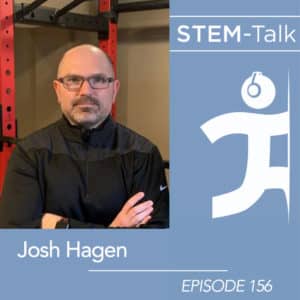
Hagen, who appears on Episode 156 of the STEM-Talk podcast, was part of a longitudinal study of changes in a baseball player’s maximal strength as a result of resistance training. The study focused on the impact the exercise had on total home runs per game across three years of training in four competitive seasons for four teams.
“Baseball is a fascinating sport when it comes to math and statistics,” Hagen says. “As far as American sports, baseball has gone head-first into statistics. I’ve been floored by the amount of staffing and infrastructure these teams have (around data)…. Every swing, every pitch is biomechanically analyzed.”
Hagen’s STEM-Talk is co-hosted by IHMC Founder Ken Ford and IHMC’s Chief Strategic Partnership Officer Dr. Morley Stone, who has had an instrumental role in Hagen’s career.
The conversation covers Hagen’s work at the Human Performance Collaborate, which brings together multidisciplinary teams of researchers, sports scientists, data scientists, and practitioners with the goal of optimizing human performance in Ohio State athletes.
Hagen credits his high school chemistry teacher who made chemistry lively and compelling, with kickstarting his scientific career. Even when the challenges of his first semester at the University of Cincinnati studying to be a chemical engineer became clear, Hagen decided to push on.
Hagen’s first job in private industry felt like a grind he couldn’t bear for the rest of his life.
“I was watching a more senior engineer doing the same things I was doing and he’d been doing it for 20 years. I just thought, ‘I don’t think I can do this for 20 years.’”
Advice from another trusted teacher led Hagen to pursue a Ph.D., which led to work at Wright Patterson Air Force Base, where he would first meet Stone. The rest is history.
Within human performance research, Hagen leads two areas: Sport and Tactical Performance Science and Recovery Science. At Ohio State, Hagen works with other performance science researchers to evaluate the physical traits and capabilities of athletes. They collaborate with coaches and athletic trainers to make adjustments in the weight room, on the field, and during recovery after training or competitions.
Hagen also works on federally funded projects with Special Operations Command, The Air Force Research Laboratory, the Office of Naval Research and several private foundations. He joined IHMC in 2022 as a Visiting Senior Research Scientist.
The conversation is wide-ranging and includes:
— How lessons Hagen learned from his time in the private sector, at the Air Force Research Laboratory, and at West Virginia University, fed into his work at Ohio State University as the director of the Human Performance Collaborative.
— Hopes that while his team largely works with two populations — sports athletes and the military — the applications of what they learn could be far-reaching. “We’re trying to maximize human performance for all humans, that sounds like a ridiculous, broad objective, but that is really what we’re trying to do,” Hagen said. “Every one of us can be optimized to some level.”
— What Hagen means by “the need to understand performance on a system level” and how training-load monitors work to create usable feedback for athletes.
— Hagen’s 2020 paper on monitoring neuromuscular performance in military personnel.
— Hagen’s study of popular commercial off-the-shelf wearables that give health data to consumers. The study looked at the accuracy of heart rate variability, sleep, and heart rate data that these devices track.
— Hagen’s study conducted on firefighters titled “Biomarker and Biometric Indices of Physical Exhaustion in the Firefighting Community.”
— Hagen’s work with the Air Force’s 711th Human Performance Wing on a project he has led for the past decade called STRONG (Signature Tracking for Optimized Nutrition and TraininG), which aims to develop physical training routines and nutritional approaches that can enhance a warfighter’s performance and resilience.
— An overview of IHMC’s research project that involves Hagen, Ohio State University, and the STRONG lab, called A2PEX (Assessing and Augmenting Performance in Extreme Environments). A2PEX aims for real-time assessment of a special operator’s cognitive performance over long-duration missions, often in extreme environments, as well as developing wearable devices and an integrated system that will help warfighters overcome fatigue and stress by continually sensing and assessing their performance.
IHMC is a not-for-profit research institute of the Florida University System where researchers pioneer science and technology aimed at leveraging and extending human capabilities. IHMC researchers and staff collaborate extensively with the government, industry and academia to help develop breakthrough technologies. IHMC research partners have included: DARPA, the National Science Foundation, NASA, Army, Navy, Air Force, National Institutes of Health, IBM, Microsoft, Honda, Boeing, Lockheed, and many others.
Back-to-school means back to Science Saturdays at IHMC
The Florida Institute for Human and Machine Cognition is where Gabriela Sullivan’s passion for science education flourished.
This fall, she’s coming back to share it with the next generation.
As a high schooler, Sullivan was a regular volunteer at IHMC’s Science Saturdays STEM enrichment program for students in grades 3 through 6. She remembers being in awe of the researchers and teachers who could encourage and inspire a room full of young minds.
“Their ability to convey complex concepts in a way that was both understandable and exciting fascinated me,” she said. “It made me want a career that involved science education.”

Gabi Sullivan will lead a Science Saturdays session in 2023.
She made that dream a reality. Sullivan graduated from the University of Florida and now works for the City of Ocala as water conservation coordinator. In October she will lead a Science Saturday of her own at the Ocala campus. Her topic will be healthy wetlands.
“Today’s youth will be the scientists of tomorrow, and throughout my session, I want students to feel engaged and included, knowing that there is a place for them in the field of science,” she said.
For nearly 16 years, Science Saturdays has been opening doors for kids like Sullivan. IHMC’s popular monthly science enrichment series starts its next season Sept. 30 in Pensacola and Sept. 9 at the Ocala campus. Sessions slated for the fall include science of the mind, game design, healthy wetlands and more.
Dr. Ursula Schwuttke is the director of educational outreach for both IHMC’s Pensacola and Ocala campuses. Schwuttke says that the impact of the series is what keeps it compelling for families — and for IHMC staff.
Sometimes the impact is immediate — seeing the spark of imagination and engagement in a child’s face. Sometimes the reveal takes longer, but the payoff is immense.
Sullivan is a perfect example of that.
“Knowing that I can share my knowledge with students is a full-circle moment,” Sullivan said. “What makes it even more exciting, is that I get to talk about the science of water and wetlands, two areas of study that are often overlooked, but incredibly important to maintaining healthy a society.”
Roman Bassett is a Pensacola High School graduate who now attends the University of Florida studying mechanical engineering. Bassett was a Science Saturdays volunteer in Pensacola and said it was an experience that made him realize how deeply invested in subjects he could become. It also helped him realize how much he enjoyed teaching and learning together, including both with younger students and with peers.

Roman Bassett is a previous Science Saturdays volunteer.
He still distinctly remembers lessons from Science Saturday, including homemade electric motors and paper planes. He hopes that future Science Saturdays attendees leave with the same message he took from the experience: Have fun learning.
“Exploring your interests and learning cool new things is one of the most exciting things you can do” he says.
Last school year, more than 330 students from 28 Escambia and Santa Rosa elementary schools attended these weekend sessions.
- 42 percent of attendees are female; 58 percent were male.
- Parents of girls reported greater impact on scientific curiosity, self-confidence in science, and self-confidence overall.
- Boys and girls alike got a boost in their enjoyment of science and grades in science from Science Saturdays.
“We see that Science Saturdays makes a difference in the lives of our students, and we are grateful to our sponsors for helping us reach families who might not be able to offer their children hands-on science if our events weren’t free,” Schwuttke said.
The sessions are free and sign up is available at https://www.ihmc.us/life/science_saturdays/
In Pensacola, Premier Community sponsorship from Florida Power & Light supports the series. Annual sponsors Florida Blue Foundation and Cox, and season sponsors Escambia Sheriff’s Office, Barnes Insurance, and International Paper Foundation help make the Pensacola sessions possible. In Ocala, sponsors Lockheed Martin, Florida Blue Foundation, Cox, Ron and Phyllis Ewers, and Precision Sidewalk Safety support the series in that community.
SCIENCE SATURDAY FALL SCHEDULE
The schedule for Science Saturday for the Fall is complete. Share the link with friends with children in grades 3-6 https://www.ihmc.us/life/science_saturdays/
Pensacola Sessions
Sept. 23: Science of the Mind, Dr. Kevin Gluck.
Oct. 28: Electric Motors, Dr. Robert Griffin.
Nov. 18: Computer Game Design, Heath Parr, Brown-Barge Middle School.
Dec. 17: Illusions, Dr. Toshi Miyatsu.
Ocala Sessions
Sept. 8: The Lives of Moths, Dr. Andrei Sourakov, University of Florida.
Oct. 7: Healthy Wetlands, Gabriela Sullivan, City of Ocala.
Nov. 11: Computer Game Design, Dr. Ian Perera.
Dec. 2: Arash Mahyari, Electric Circuits .
IHMC is a not-for-profit research institute of the Florida University System where researchers pioneer science and technology aimed at leveraging and extending human capabilities. IHMC researchers and staff collaborate extensively with the government, industry and academia to help develop breakthrough technologies. IHMC research partners have included: DARPA, the National Science Foundation, NASA, Army, Navy, Air Force, National Institutes of Health, IBM, Microsoft, Honda, Boeing, Lockheed, and many others.
Robotics Camp fires students’ STEM excitement through hands-on learning
This summer, the ordinarily quiet classrooms of the Florida Institute for Human and Machine Cognition’s Pensacola and Ocala campuses became engineering playgrounds as part of 2023 Summer Robotics Camp.
Over the course of four, one-week sessions, 66 middle and high schoolers got these hands-on experiences and more designing their own LEGO robots, learning the basics of computer programming, and interacting with researchers.
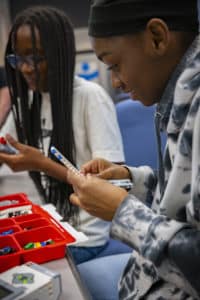
Teamwork is a big part of Summer Robotics Camp
“We are reaching out to the next generation of scientists, helping them to discover what their future might look like,” said Dr. Ursula Schwuttke, IHMC’s Director of Educational Outreach.
Any future in STEM requires strong teamwork and problem-solving skills, and Robotics Camp is designed to teach just that.
Under the guidance of IHMC staff and volunteers from local high schools, campers worked in pairs to assemble LEGO Mindstorms robots. Students then used a block-based, visually appealing coding language to guide their creations through mazes and obstacle courses, debugging code and redesigning robots as they went. Campers attending the second Ocala session also learned how to program in Python.
“You don’t get too many chances to actually mess around with robots in day-to-day life,” said Max Truong, a former Science Saturdays attendee who is now a rising senior at Tate High School and a Pensacola camp volunteer. “Giving the kids that opportunity to build and code something themselves is pretty great.”
In addition to real-life engineering experience, Robotics Camp also provides students with inspiring professional role models. During the daily “Lunch With a Scientist” sessions, IHMC researchers explain their work and answer campers’ questions over a meal.
In Pensacola, these sessions included an interactive virtual reality demonstration from Senior Research Associate John Carff and Research Scientist Dr. Matt Johnson, exoskeleton exploration with Research Scientist Dr. Gwen Bryan, an introduction to brain science and human performance research from Research Scientist Dr. Toshi Miyatsu, and the ever-popular IHMC robotics lab tour. Heath Parr, a teacher at Brown-Barge Middle School, provided the daily robotics challenges and instructions.
During the Ocala sessions, IHMC staff introduced campers to concepts in computer game design (Research Scientist Dr. Ian Perera), natural language processing (Research Scientist Dr. Archna Bhatia), and artificial intelligence (Senior Creative and Multimedia Specialist William Howell).
Quantum Improvements Consulting Senior Scientist Dr. Cheryl Johnson shared the concept of human factors with campers, and Rachel Farmer and Ben Thompson, both from Lockheed Martin, gave presentations on careers in engineering.
“Sometimes you see a camper really awed by a one-on-one opportunity with an individual scientist,” said Schwuttke, recalling the connection that formed between Dr. Gwen Bryan and rising eighth-grader Sonja Christiansen.
“We had a lot of interests in common, and I thought that was awesome,” said Sonja about her conversation with Bryan. Schwuttke hopes that personal interactions like these will serve as turning points in the lives of STEM-curious campers.
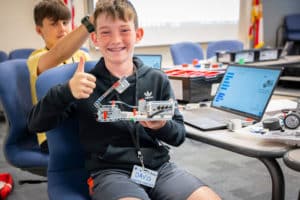
Davis Coleman at Summer Robotics Camp.
Inspiring students to engage with science and engineering is a core part of IHMC’s community outreach, but not all local students have equal access to high quality STEM education experiences. To bridge this gap, IHMC provides free camp registration and lunch to qualifying students. These need-based scholarships are made possible by donations from sponsors, including Cox, Lockheed Martin, CareerSource, the Mid-Florida Regional Manufacturers Association, and the Escambia County Sheriff’s Office.
“I always thought that I might want to pursue robotics and engineering,” said rising eighth-grader Davis Coleman, an exceptionally enthusiastic Pensacola participant. “After camp, now I know that I do.”
Touring the robotics lab, designing a robot of his own, and meeting with research scientists all combined to spark a new career goal for Davis: “I hope one day after school I can come back to work at IHMC.”
Subscribe to the Robotics Camp email list here to be in the know for future sessions.
STEM-Talk: Dr. Chris McCurdy on kratom and pain management
What if the roots of a secret to treating chronic pain has lain for centuries in the tree leaves of a Southeast Asian evergreen?
Dr. Chris McCurdy has spent the last 15 years of his career researching that question, with a focus on the medical efficacy of kratom and its alkaloids.
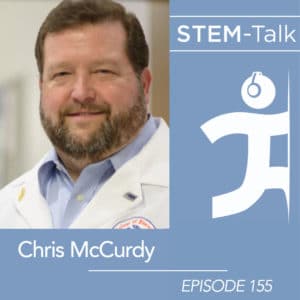
Now, he’s back on STEM-Talk after five years to share what he and his lab at the University of Florida have learned since his 2018 interview on episode 61. McCurdy and his lab received two major grants from the National Institute of Drug Abuse to investigate kratom and its chemical components to better understand its potential to treat a multitude of conditions.
“One of the things that has been touted about kratom is that it does give energy,” McCurdy notes. “Its traditional use was to boost energy for outdoor labor in the hot humid tropical environment of Southeast Asia. It has this sort of paradoxical effect of stimulation but also euphoria” at different dosing levels.
Kratom has been used in herbal medicine for hundreds of years to boost mood, energy and pain relief. Though it has become popular throughout the world for recreational purposes, it is being recognized in the medical and research communities for its treatment for chronic pain and its potential to alleviate opioid withdrawal symptoms.
“There’s a lot of interest in pain,” McCurdy said. “Our focus has been looking at the opioid crisis and trying to understand how kratom could be used in opioid use disorder…. But certainly, pain is really an unmet need.”
“We do need desperately for something to be as efficacious (as opioids) in pain treatment, but hopefully without the liabilities. And we see that kratom could be something promising in that area.”
For more than 25 years, McCurdy has studied the design, synthesis, and development of drugs to treat pain, anxiety, and substance-abuse disorders. He is a professor in the Medicinal Chemistry Department in the College of Pharmacy at the University of Florida. He also is director of the of school’s Translational Drug Development Core and an Associate Dean for Faculty Development.

Kratom (Mitragyna speciosa)
In today’s interview, we talk about:
— The disparity between the traditional use of kratom (in tea form brewed from freshly picked leaves) and the new often highly concentrated manufactured products sold in the U.S.
— His lab’s study examining the effects of lyophilized kratom tea and its ability to alleviate withdrawal symptoms of opioid-dependence.
— The potential of kratom alkaloids to serve as treatment for substance abuse disorders.
— The benefits and risks associated with CBD usage.
Here’s a link to our podcast webpage where you can find the McCurdy episode and an archive of all STEM-Talk interviews.
IHMC is a not-for-profit research institute of the Florida University System where researchers pioneer science and technology aimed at leveraging and extending human capabilities. IHMC researchers and staff collaborate extensively with the government, industry and academia to help develop breakthrough technologies. IHMC research partners have included: DARPA, the National Science Foundation, NASA, Army, Navy, Air Force, National Institutes of Health, IBM, Microsoft, Honda, Boeing, Lockheed, and many others.
IHMC researchers collaborating with American Magic team
New York Yacht Club American Magic’s move to Pensacola has resulted in a collaboration with the Florida Institute for Human and Machine Cognition (IHMC).

The New York Yacht Club American Magic. Credit: American Magic team.
Since 2018, the professional sailing team has used the Port of Pensacola for seasonal training. In 2023, they decided to make Pensacola their permanent home. This strategic move is expected to generate 170 jobs in advanced manufacturing, engineering, design, and high-tech research and development.
The collaboration originated when Pensacola Mayor D.C. Reeves included IHMC on a city tour with the racing team.
“Soon after this introduction, members of the IHMC team toured the American Magic facilities, and the brainstorming began,” said Ryan Tilley, IHMC’s director of strategic program execution and innovation.
Leading the collaboration for IHMC has been Research Scientist Dr. Matt Johnson. Johnson said that on the tour, the team highlighted a number of technical challenges they were working on, including improving the interface used by the crew.
“They are constantly developing and testing new ideas,” Jonson said. “Considering IHMC’s experience designing interfaces for advanced technology, it was a natural fit for collaboration between the two organizations.”
Johnson’s research areas include human-machine teaming, human-machine system design, human-centered computing, human-machine interface design, and multi-robot control.
The goal of any new interface design is to improve the team’s overall performance. Johnson says the interface design challenge is complicated. “Not only is the yacht itself complex, but it is also part of a greater system that involves eight crew members, each with their specific roles.”
American Magic can be described as an “airplane on water… operated in a harsh, unforgiving environment where success hinges on narrow margins.” Johnson says. “The interface plays a crucial role in seamlessly integrating the crew with the yacht, ensuring that each crew member has access to the essential information required to fulfill their respective roles.”
During a race, the demands on the team are extraordinary, so improving their ability to interpret system status quickly and intuitively is the goal.
Johnson says IHMC has completed an initial analysis and the human-centered assessment approach has already proven helpful to the American Magic team.
Working with IHMC on this project has benefited the team tremendously, said Anderson Reggio, Performance Manager of NYYC American Magic.
“It has allowed our engineers to integrate ideas and suggestions from skilled subject matter experts that we do not typically encounter in the yachting world,” Reggio said. “It has been a phenomenal start to our relationship, and we hope that it will provide us with a competitive edge when we begin racing in Barcelona.”
Tilley expressed optimism that this collaboration is the beginning of a long and fruitful partnership: “We look forward to a long-term relationship providing solutions for the American Magic team and hope to play a small role in their future victories.”
IHMC is a not-for-profit research institute of the Florida University System where researchers pioneer science and technology aimed at leveraging and extending human capabilities. IHMC researchers and staff collaborate extensively with the government, industry and academia to help develop breakthrough technologies. IHMC research partners have included: DARPA, the National Science Foundation, NASA, Army, Navy, Air Force, National Institutes of Health, IBM, Microsoft, Honda, Boeing, Lockheed, and many others.
STEM-Talk: Dr. Brian Cole on advances in knee, shoulder, and elbow injuries
You can thank Bob Newhart for Dr. Brain Cole’s career.
The classic 1970s sitcom gave Cole, then an impressionable middle schooler, a vision of the impact a physician could have on the lives of patients with good humor.
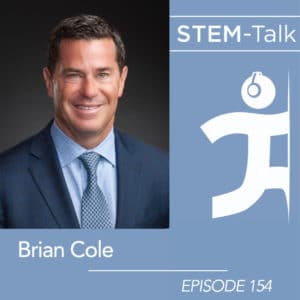
“If you ask any individual in health care, the reason I chose this is I love to help people,” Cole says on the latest episode of STEM-Talk. “On ‘The Bob Newhart Show’ he was able to help people, but he did so with a sense of humor.”
Something about the low-key way that psychology, sociology and humor fit together to make an impact on people appealed to young Cole. He says he has carried that with him throughout a career that led him to becoming a renown orthopedic surgeon.
Today on STEM-Talk, Cole shares his journey with Dr. Ken Ford, IHMC’s founder and chief executive officer, and Dr. Marcas Bamman, Senior Research Scientist at IHMC.
Cole specializes in cartilage restoration, orthobiologics, and advanced surgical techniques for the treatment of knee, elbow, and shoulder injuries. He is the team doctor for the NBA’s Chicago Bulls and the co-team doctor for the Chicago White Sox. He also is the host of the Sports Medicine Weekly Podcast.
He practices at Midwest Orthopaedics, where his Master’s in Business Administration (MBA) is used in his role as managing partner of the practice.
On STEM-Talk, Cole talks about his cutting-edge research into ways to treat knee, shoulder, and elbow injuries. He also shares his novel approach to dealing with ACL tears, one of the most common sports injuries, and his investigations of methods to enhance the healing and recovery time following ACL reconstructions.
Interview highlights include:
- Cole’s experience with professional athletes in the role as head team physician for the Chicago Bulls and the co-team physician for the Chicago White Sox.
- His day-to-day practice with non-professional athletes, from children to senior citizens. “Understanding what (someone) needs and how to make a difference in their life is one of the greatest privileges… Having the privilege to see people and take care of them never gets old.”
- How he fights the prevailing trend of “technology over reason” in medicine to focus on treating his patients and not on an X-ray or an MRI. It boils down to two concepts dubbed the “Brainless Application of Radiologic Findings” (BARF) and being a “Victim of Modern Imaging Technology” (VOMIT).
- The impact that weight loss can have on knee pain. “I have a number of patients that I’ve made feel better through lifestyle modification and never giving them an injection, never doing surgery on them, just having a conversation. It is an enormous part of the holistic approach to managing patients.”
- What is behind the huge jump in ACL tears among 14- to 18-year-olds, which have increased by 148 percent over the past 10 years, and what strategies are evolving to enhance ACL healing and accelerate recovery.
- Discussion of the best treatment of meniscal tears, one of the most common pathologies in sports medicine.
- Treatment of rotator cuff repair, shoulder replacements, soft tissue injuries, osteoarthritis, the use of stem-cells, bone marrow aspirate and more.
IHMC honors seven colleagues with emeritus status
At the Florida Institute for Human and Machine Cognition (IHMC), we stand on the shoulders of those who have come before us.
This month, IHMC honored seven people who helped build the Institute from a closet in the computer science department at the University of West Florida into a research center with an international reputation in artificial intelligence, computer science, robotics and exoskeletons, and healthspan, resilience, and performance research.
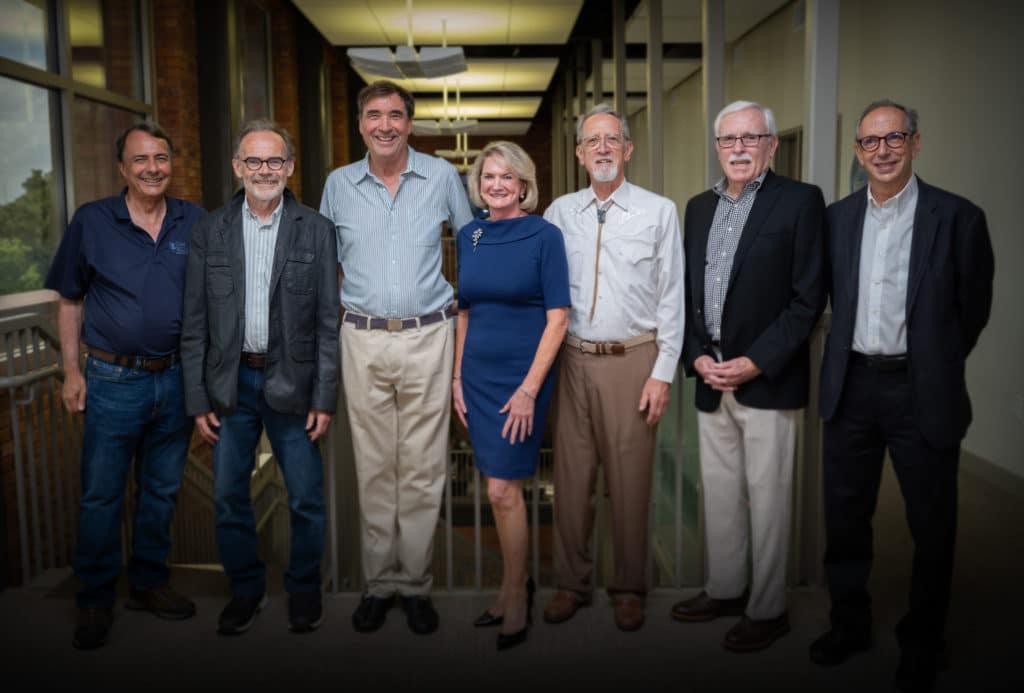
The 2023 Emeritus Class of the Florida Institute for Human and Machine Cognition.
“Without the contributions of these individuals, IHMC quite simply would not be where it is today,” said Founder and CEO Dr. Ken Ford. “Their own sense of commitment to excellence inspired, and continues to influence, the culture of IHMC. We are grateful to each of them.”
The honorees named to Emeritus status were:
Senior Research Scientist Emeritus, Dr. James Allen

Dr. James Allen Credit: J. Adam Fenster, University of Rochester
Dr. Allen is a pioneer in artificial intelligence with substantial contributions to natural language understanding research. He is a professor emeritus at the University of Rochester where he has been on the faculty since 1978. Dr. Allen joined IHMC in 2006 and served as an Associate Director.
Computational linguistics is at the root of speech recognition systems, text-to-speech synthesizers, automated voice-response systems, internet search engines, text editors, language instruction material and more.
His research uniquely combines what often are treated as separate fields in artificial intelligence — knowledge representation and reasoning, language understanding, planning, intention recognition, and learning.
Senior Research Scientist Emeritus, Dr. Jeffrey M. Bradshaw

Dr. Jeffrey Bradshaw
Dr. Bradshaw is a pioneer in automated knowledge acquisition and multiagent systems.
His book, “Software Agents” is a classic in the field of multiagent systems and is one of several books he has authored. Since 2000, the research group Dr. Bradshaw led at IHMC developed a framework for distributed systems management and human-agent-robot teamwork.
This framework has been used in scores of government-sponsored and commercial projects for network management, secure policy-based governance of complex systems, and for the coordination of human-robot teams.
Senior Research Scientist Emeritus, Dr. Alberto Cañas

Dr. Alberto Canas
Dr. Canas is a co-founder of IHMC, an innovator in knowledge modeling and the creator of CmapTools, a software tool used by schools, businesses, and organizations across the globe.
His IHMC research projects include knowledge modeling, performance support systems, collaborative tools for education and research, distance learning, and corporate memory.
CmapTools is an outgrowth of Dr. Cañas’ interest in the use of technology in the K-12 education system. Before going to the University of West Florida, he was the director of IBM’s Latin American Education Research Center in Costa Rica.
His research includes the use of computers in education, knowledge management, knowledge acquisition, information retrieval, and human-machine interface.
Senior Research Scientist Emeritus, Dr. William J. Clancey

Dr. Bill Clancey
Dr. Clancey is a computer scientist whose research relates cognitive and social science in the study of work practices and the design of agent systems.
Before joining IHMC in 1997, Dr. Clancey was at the Institute for Research on Learning in Menlo Park, Calif., from its founding in 1988, where he co-developed the Brahms multi-agent work practice modeling and simulation system. At the NASA Ames Research Center, where he served as Chief Scientist of Human-Centered Computing in the Intelligent Systems Division. His team developed the Mobile Agents software that automates file processing between Mission Control and the International Space Station.
At Stanford’s Knowledge Systems Lab, he developed some of the earliest AI programs for explanation, meta-level reasoning, the critiquing method of consultation, tutorial discourse, and student modeling.
Senior Research Scientist Emeritus, Dr. Robert Hoffman

Dr. Robert Hoffman
Dr. Hoffman is a recognized leader in cognitive systems engineering and human-centered computing. His research has centered on knowledge modeling, work analysis, cybersecurity, expertise studies, and several others.
Dr. Hoffman has been recognized internationally in cognitive systems engineering, applied psychology, artificial intelligence, and human factors engineering—for his research on the methodology of cognitive task analysis and human-centering issues for human-systems integration systems technology.
He has co-authored and co-edited 18 scholarly books and is co-author on over 100 publications in peer-reviewed journals.
Deputy Director for Defense Research and Development Emeritus, Tim Wright
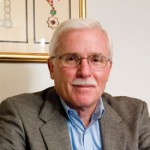
Timothy W. Wright
Vice Adm. Tim Wright joined IHMC in 1996 as deputy director after having served for 35 years in the U.S. Navy. As a Naval aviator, he served primarily in fighter squadrons during his active flying career. He commanded a fighter squadron, a carrier air wing, a fleet oiler, an aircraft carrier, a carrier battle group and the U.S. Seventh Fleet.
He holds a bachelor’s degree in engineering from the Naval Postgraduate School in Monterey, Calif., and a master’s degree in public administration from George Washington University. He also is a graduate of the Industrial College of the Armed Forces at the National Defense University.
Board of Directors Emeritus, Carol Carlan
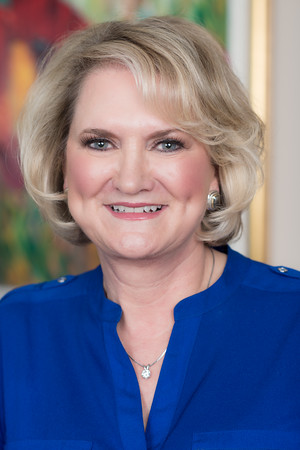
Carol Carlan
Carol Carlan was the inaugural chair of IHMC’s Board of Directors and now serves as the Institute’s director of philanthropy. Her leadership helped guide the Institute from its early years to its status as a premier research institution.
Her banking career spanned more than 35 years culminating in serving as the first female president of a large regional bank. As the President of the Ascension Sacred Heart Foundation, she led one of the largest capital campaigns in the region, resulting in a new children’s hospital and expansion of children’s services in the Destin market.
As President of Carlan Consulting, she is a founding member of the John Maxwell Team, a global training organization for leaders with more than 50,000 members worldwide.
Among the numerous accolades she has received: Pensacola Chamber PACE Awards recognized her as the Spirit of Pensacola and Business Leader of the Year, Leadership Pensacola gave her the Blue Angel Leadership Award, a participant of the Leadership Florida Class of 2011-2012, recognized for her many years of work as a Trustee of the Pace Center for Girls State Board of Trustees she was awarded the 25th anniversary Pioneer Award.
IHMC is a not-for-profit research institute of the Florida University System where researchers pioneer science and technology aimed at leveraging and extending human capabilities. IHMC researchers and staff collaborate extensively with the government, industry and academia to help develop breakthrough technologies. IHMC research partners have included: DARPA, the National Science Foundation, NASA, Army, Navy, Air Force, National Institutes of Health, IBM, Microsoft, Honda, Boeing, Lockheed, and many others.
STEM-Talk: Dominic D’Agostino on latest research into therapeutic ketosis
Longtime listeners know Dr. Dominic D’Agostino’s reputation and his research into the physiological benefits of nutritional ketosis. Since his last STEM-Talk in 2019, a tremendous body of research has been added to the literature about the therapeutic potential of ketosis.
Listen to Episode 153 now or wherever you listen to podcasts.
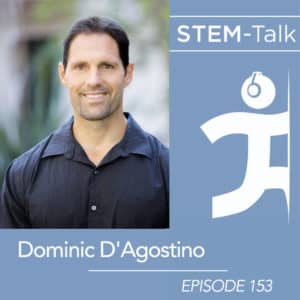
Dominic D’Agostino returns for a third appearance on STEM-Talk.
The high-fat, low-carb ketogenic diet has been linked to advances in the treatment of:
• Alzheimer’s
• Cancer
• Migraines
• Type-2 diabetes
• Psoriasis
• Sleep apnea
• Psychiatric disorders
• Traumatic brain injuries
• And a host of other diseases and disorders, which we cover in today’s interview.
D’Agostino is an IHMC colleague and a tenured associate professor of molecular pharmacology and physiology at the University of South Florida Morsani College of Medicine. He specializes in neuroscience, molecular pharmacology, nutrition, and physiology.
In this episode, hear our conversation about:
— Evidence-based applications of the ketogenic diet on neurodegenerative disorders such as epilepsy, Alzheimer’s Parkinson’s disease.
— Possible applications for the ketogenic diet in the treatment of schizophrenia, bipolar and other psychiatric disorders.
— Research on whether therapeutic ketosis via ketone esters could help treat epilepsy and other seizure disorders.
— Studies that examined the effects of a ketogenic diet on athletic performance.
— The impacts that hyperbaric oxygen therapy may have in areas including traumatic brain injury.
— The NASA project NEEMO that sends crews of astronauts, aquanauts, engineers, and scientists to live in a facility at the bottom of the Atlantic.
— How life on a farm has changed his family.
You also can watch D’Agostino’s 2023 Evening Lecture in Pensacola here. Listen here to D’Agostino’s first appearance on STEM-Talk in 2016.
Retired Air Force Maj. Brian Shul leaves legacy of survival with his passing
“Leaving your jet in the jungle is not heroic. I’m a survivor.”
That sentiment is one that Retired Air Force Maj. Brian Shul expressed often in the years after being shot down during the Vietnam War. Sustaining devastating burn injuries in the crash, he recovered and continued to serve his country, piloting secret missions in the Cold War while flying the SR-71, the world’s fastest aircraft.
He told his story often as part of his encore career in which he continued to inspire. Telling his story was among the last things he did. He died of a cardiac arrest in a hospital in Reno, Nev. On May 20, 2023. He had collapsed while speaking at the Nevada Military Support Alliance’s annual event, according to news outlets. He was 75.
Back in 2015, the Florida Institute for Human and Machine Cognition was honored to host Shul for an Evening Lecture. You can watch his talk here.
He also was a guest on IHMC’s podcast SEM-Talk in episode 15. Listen to that conversation here.
A2PEX project leads latest edition of IHMC newsletter
How long can you sustain attention in a cognitively or physically demanding situation where a lapse in focus due to boredom or fatigue could have life-or-death consequences?
That’s the question at the heart of a cooperative research project between the Florida Institute for Human and Machine Cognition (IHMC) and the Air Force Research Laboratory (AFRL) now under way.
The project is the cover story of the latest issue of our newsletter, available here.
Assessing and Augmenting Performance in Extreme Environments (A2PEX) aims for real-time assessment and augmentation of Airmen cognitive performance in long-duration missions in extreme environments.
The goal is to develop robust wearable devices and an integrated system that overcomes fatigue and stress by continually sensing, assessing, and augmenting human performance. The five-year project is sponsored by AFRL’s Materials and Manufacturing Directorate and supported by the 711th Human Performance Wing.
Principal Investigators are IHMC’s Dr. Morley Stone and Dr. Tim Broderick. It draws on team members from IHMC’s human performance, robotics, and human-centered computing teams, and on Stone’s earlier work within AFRL on the Sense, Assess, Augment paradigm.
Broderick says A2PEX “…is developing and manufacturing materials and technologies that will allow us to sense key biomarkers of fatigue in extreme environments, and to augment performance by mitigating fatigue. Aviation mishaps often are related to unrecognized fatigue and stress.”
“If we can recognize and mitigate stress and fatigue, we can potentially save lives,” he says. “It is very hard to accurately measure the physiology and performance of a person during everyday activities – and even more so when a person works in an extreme environment.”
Academic partners in the project are The Ohio State University and Georgia Institute of Technology. Industry partners are Triple Ring Tech, Abbott Biowearables, electroCore, and Polar.
“We are excited about the possibilities of this program,” says Regina Shia, program manager at AFRL. “HMC has built a strong team with expertise that ranges from physiological and cognitive monitoring to materials and manufacturing advances. With a closed-loop human sustainment for a long-duration mission’s objective, this team could immensely impact the combat readiness and lethality for the Air Force.”
Research agreement is key
Closing the loop for human performance has been a longtime interest for IHMC researchers. More than a decade ago Stone published on the concept of the Sense, Assess, Augment — a human-centric control loop to improve performance.
“Without the cooperative research agreement, we would not have access to AFRL research infrastructure that allows us to move sense and augmentation concepts out of the lab and into relevant environments. It’s a key component for us as we move into verification and validation before field testing,” Stone says.
“We have a long-standing and productive relationship with the Air Force,” Broderick says. “We’re working with them in a collaborative way that is not typical. The collaboration benefits both parties and accelerates results.”
The first year of the project will focus on refining and testing partner devices at IHMC and in the STRONG Lab (at Wright-Patterson Air Force Base). Triple Ring and Ohio State researchers are prototyping devices that will be tested in a joint exercise later in 2023. That exercise could include:
— Air Force special operators and medics using personal protective equipment during a five-day surge;
— Aircrew during long duration flights in the Pacific theatre;
— Remotely Piloted Aircraft (RPA) teams during high tempo, protracted missions; and
— Intelligence, Surveillance, and Reconnaissance (ISR) analysts during long shifts in classified facilities.
Year two will focus on analyzing the data generated and revising prototype devices and the integrated system.
The goal is to supply a sensor system that is comfortably wearable and doesn’t pose a safety risk, yet still supplies accurate electrical and mechanical data in a range of hostile environments.
“If it’s not able to be worn comfortably, or if it gets in the way of doing a mission, it won’t be used,” Broderick says.
Partners Polar, Abbott Biowearables, and Triple Ring are key to the effort to maximize adaptation of existing technologies to the needs and demands of the populations A2PEX will serve.
The Air Force is interested in what this might mean for aviators on long-duration missions, but it’s not only pilots who could benefit. Personnel who engage in long-duration, high-cognitive load activities – such as pilots flying unmanned vehicles or analysts reviewing reconnaissance images – also could benefit.
A promising approach for A2PEX centers on noninvasive vagal nerve stimulation. The vagal nerves are gatekeepers of the autonomic nervous system. These nerves send messages that adjust cognitive function and alertness, which are especially important to those working for extended stretches of time in high-stress environments.
How A2PEX came to be
The thread of A2PEX can be traced back more than a decade, with ties to work Stone did with AFRL and work Broderick was part of with the Defense Advanced Research Projects Agency (DARPA), particularly with the Peerless Operator Biological Aptitude, (PEERLESS).
That project was designed to increase the biological aptitude of warfighters so that they can increase their adaptability and resilience in extreme conditions.
In those early years, researchers were gaining the ability to measure quantitative data on human performance. With that knowledge, researchers gained the opportunity to fill a gap in the optimization of a system that until then had focused on how the technology performed — but hadn’t fully accounted for the impact on the human operator.
The confluence of neurology, biomarkers, and wearable technology made this a “sweet spot” for optimizing the performance of elite warfighters and the technologies they control. PEERLESS, and now A2PEx, originate at least in part from this space.
For A2PEX, researchers are looking for the intersection of what researchers would like to measure, what materials and sensors need to be developed, and how it can enhance capability and safety in extreme environments.
While focus has been on pilots on long-duration missions, Stone and Broderick both note that the same concerns about how fatigue and biology could impact cognitive focus and accuity, other personnel could benefit from A2PEX’s findings.
Analysts working extended shifts in Sensitive Information Compartmented Facilities (SCIF) and those working on Intelligence Surveillance Reconnaissance also face demands on their attention and focus. A2PEX could benefit them as well.
The implications for military operators are clear, but the findings could ultimately produce benefits for long-haul truckers, commercial pilots on transoceanic routes, and medical personnel working long shifts, Stone notes.
IHMC is a not-for-profit research institute of the Florida University System where researchers pioneer science and technology aimed at leveraging and extending human capabilities. IHMC researchers and staff collaborate extensively with the government, industry and academia to help develop breakthrough technologies. IHMC research partners have included: DARPA, the National Science Foundation, NASA, Army, Navy, Air Force, National Institutes of Health, IBM, Microsoft, Honda, Boeing, Lockheed, and many others.
STEM-Talk: Dr. Mark Shelhamer on human spaceflight and missions to Mars
Mark Shelhamer was set upon a path that would take him from “nerdy band kid” to the chief scientist for NASA’s Human Research Program by his Uncle Stanley.
“One of the smartest people I knew, even though he was not highly educated,” Shelhamer says. “He had been a surveyor in a coal mine. He was ‘the cool uncle,’ so he made it cool to be interested in science and math.”
Uncle Stanley also gifted 10-year-old Mark with a Radio Shack 150-in-1 Electronics Kit. The idea that he could wire up a radio in a few minutes and listen to broadcasts from hundreds of miles away on something he built with his own hands, “was magic to me.”
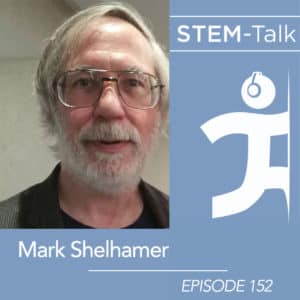
Dr. Mark Shelhamer on Episode 152.
He’s been using that magic ever since in a career spent learning about spaceflight and its impact on human beings. In this STEM-Talk, Shelhamer talks about his work with NASA and as an advisor to the commercial and consumer spaceflight industry.
Shelhamer is an otolaryngology professor at the Johns Hopkins School of Medicine and is the director of the school’s Human Spaceflight Lab. He also the director and founder of the Bioastronautics at Hopkins initiative
This fascinating discussion covers his role in NASA’s planned human mission to Mars and how he is investigating ways to maintain the health and performance of astronauts on long-duration spaceflights. He also discusses how this knowledge could be applied to improving healthcare on Earth.
Episode 152 is now available on IHMC’s STEM-Talk webpage, as well as on your favorite podcast platform. Tune in for the conversation hosted by Dr. Ken Ford, IHMC’s founder and CEO, and co-host Dawn Kernagis, which covers:
- How Shelhamer’s family ties to nursing led him to biomedical engineering, and ultimately, Massachusetts Institute of Technology and Johns Hopkins University.
- Shelhamer’s research into motion sickness and vestibular issues and his more recent work on Space Motion Sickness.
- Hiss belief in the need for a multidisciplinary approach to human space flight research — and how that approach could improve healthcare systems on Earth.
- How close he believes we are to another exciting time with NASA’s Artemis program and plans to return to the moon.
- His work on the effects of space radiation on people as well as the behavioral risks of being confined with a small group of people in tight quarters on a long-duration spaceflight.
IHMC supports veterans’ transition to civilian work through SkillBridge program
The transition from military to civilian life comes with challenges, including how to translate that experience into the civilian workplace.
The Florida Institute for Human and Machine Cognition is proud to be part of a U.S. Department of Defense (DoD) program to help close that gap.
SkillBridge is a DoD program to give military personnel civilian work experience in the last 180 days of their service career — a bridge from one world to the next. This spring, IHMC renewed its commitment to the program becoming a SkillBridge worksite.
The DoD covers salary and benefits while in the program, which allows IHMC to train and leverage highly skilled service members in preparation for permanent roles at no cost, said Ryan Tilley, IHMC’s director of strategic program execution and innovation.
“SkillBridge gives IHMC early access to the experience, skills, and unmatched work ethic service members bring to the table,” Tilley said. “It’s a huge benefit to us.”
The SkillBridge partner vetting process was updated in January 2023. As part of that process, IHMC had to craft a comprehensive training plan and model the job description for the role that the service member may fill.
That included details such as job description, length of training, detailed timeline, defined training modules, specific learning objectives, instructional models, instructor qualifications, assessment/grading rubrics, as well as goals and training outcomes, Tilley said. Once approved, IHMC executed a Memorandum of Understanding (MOU) with the DoD to formalize its program approval.
A SkillBridge internship was the perfect way for Meredith Yeager to transition from a 24-year career in the U.S. Navy to a role at IHMC.
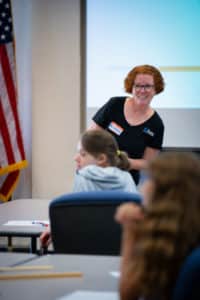
Research Associate Meredith Yeager led a Science Saturday session recently.
Yeager, who retired as a captain, is now a senior research associate, parlaying her experience in program management and process improvement into a similar role with the human performance research team.
As an SkillBridge intern, Yeager worked with IHMC Senior Research Scientist Jeff Phillips on studies to counter the impacts of dehydration and hypercapnia on aviators; to develop a pressure-resistant, diver mask-fitted oculometric neurologic assessment tool; and other human performance research projects.
She gained insight into proposal writing and the research process while leveraging her skills in managing multiple government contracts including financial management and administrative contract support.
Yeager says the experience eased her transition with very little stress and helped her develop ties to a new organization.
“I couldn’t have asked for a better experience and I am very thankful for the opportunity at IHMC,” she said.
SkillBridge is just one part of IHMC’s commitment to and connection with the military community. Dr. Kenneth Ford, IHMC’s founder and CEO, is a U.S. Navy veteran.
“The skillsets that veterans have brought to our organization are innumerable, and we are grateful for the chance to help our military members be successful in their encore careers,” Ford said.
In 2021, IHMC was recognized by the U.S. Department of Labor with a 2021 HIRE Vets Medallion Award for the research center’s commitment to employing veterans. To be eligible for the award, 7 percent of a company’s workforce must be veterans. That year, nearly 13 percent of IHMC’s workforce were veterans. In 2022, that rose to 17 percent.
Team crafts tool to track neurological function in divers for Office of Naval Research
An IHMC team has wrapped up a three-year project refining an underwater eye-tracking tool to detect the early signs of neurological hazards in divers.
Neurologic decompression sickness, hypoxia, hypercarbia, and Central Nervous System (CNS) O2 toxicity, all are hazards of working in undersea environments. Small eye-movement cameras, known as video-oculographic (VOG) systems, have been used extensively for clinical assessment of eye movements, a quantifiable marker of neurologic function.
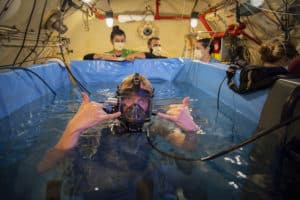
An IHMC team testing an underwater eye tracking system at Duke University.
In a project supported by the Office of Naval Research Undersea Medicine Program, the IHMC team modified the Pupil Labs ocular camera system into a waterproof form that fits in the U.S. Navy MK 20 full-face dive mask.
The Pupil Labs system is a mobile, open-source, natural gaze-based system validated across clinical and operational settings. The IHMC team is led by Senior Research Scientist Jeff Phillips and Research Associate Connor Tate.
“Navy divers are exposed to harsh conditions and high levels of stress during submerged critical missions such as search and rescue or explosive ordinance disposal,” Tate said.
Standard laboratory eye-tracking systems provide reliable measures on neurological status, but, Tate noted, “there wasn’t yet a fully waterproofed device for monitoring and evaluation in the submerged environment until our team developed one.”
The IHMC-customized design allows for adjustable use in submerged, hyperbaric settings without compromising the VOG’s ability to effectively capture eye movements.
In early 2023, the IHMC team conducted human testing on the mask they designed at Duke University’s Hyperbaric Medicine facility in Durham, N.C., to see if it would survive under water, and if the interface works.
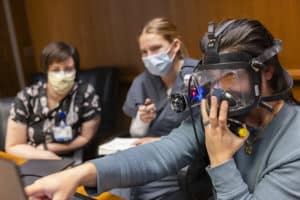
The IHMC team tested a prototype dive mask fitted with an eye tracking system to help detect early signs of neurological distress in divers.
The system is waterproofed, pressure-tested for implosion and explosion, and tested for electrical leakage — and it performed successfully in all these aspects, Phillips said. The system also was evaluated for data quality, ease of use, comfort, and the ability of the system to detect neurological changes associated with hypercapnia.
For upcoming data collection, Tate said the team will induce hypercarbia in each participant while performing a dive under pressure with the underwater eye tracking system and a system that applies machine learning to the recorded audio of the individual to predict their inhaled CO2 levels.
The combination will allow tracking of participants’ blink rates, fixations, and pupil light reflex, all of which are indicators of fatigue.
“We hope to find a positive correlation between our measures collected by the system and the participants’ CO2 levels and perceived exertion,” Tate said.
Phillips said he was proud of what his team accomplished, especially in the face of the COVID-19 pandemic and its associated supply-chain disruptions.
“Connor and the team displayed immense pluck and resourcefulness despite this being the most difficult time in recent history to accomplish this,” he said.
Bayou Texar project recruited residents for watershed monitoring
Florida Institute for Human and Machine Cognition research also includes small scale efforts in local efforts.
One such example is work by IHMC Research Scientist David Fries, who is using Bayou Texar as a test bed for a project to enlist residents in tracking the bayou’s health. It is a timely project that complements ongoing efforts to improve the waterway, which includes a nearly $6 million grant, announced by the City of Pensacola in November 2022.
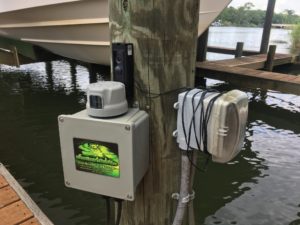
A data monitoring box as part of the Smart Waterways project.
With two grants totaling $100,000 from the Pensacola & Perdido Bays Estuary Program Community Grant Program, Fries launched a citizen science initiative with six monitoring stations linking augmented- and virtual-reality technologies with the real-world bayou. The effort aims to build a living map of the health of one of Pensacola’s signature waterways.
“The goal is to enable a water management information system, generated by the people, working with machines to better understand nature and to monitor and effect a change in the waterway,” Fries said.
Fries recruited homeowners to attach data collection devices to their docks and property lines. Those devices feed into software to analyze the data collected. It includes:
- Photos and social sharing for citizens to share photos of wildlife, water conditions, query experts about what they’ve seen.
- Measurements citizens take to track the health of the water.
- Access to a data-rich online community that includes GIS mapping data, water quality data, and a place to share personal stories about what the bayou means to its fans.
Matt Posner, executive director of the Pensacola & Perdido Bays Estuary Program, said the capabilities this initiative offers made a compelling case for support.
“The grant committee really liked that it was looking to pilot a new frontier of how we collect water quality data and how we report it to the community,” Posner said. “The more you can get citizens engaged in science, the more they take ownership of the issues and opportunities in our estuaries, the better opportunity we have to address these issues.”
Fries says he hopes the effort successfully taps into the love people have for the bayou — and gives them a chance to channel that into action. Posner looks forward to being able to continue the collaboration, and ultimately roll out the system more widely.
IHMC is a not-for-profit research institute of the Florida University System where researchers pioneer science and technology aimed at leveraging and extending human capabilities. IHMC researchers and staff collaborate extensively with the government, industry and academia to help develop breakthrough technologies. IHMC research partners have included: DARPA, the National Science Foundation, NASA, Army, Navy, Air Force, National Institutes of Health, IBM, Microsoft, Honda, Boeing, Lockheed, and many others.
STEM-Talk: Dr. John Ioannidis on flaws in COVID-19 response
In the early days of the COVID-19 pandemic, Dr. John Ioannidis wrote an article in March 2020 questioning government statistics about the fatality rate of COVID-19. The backlash was swift and brutal, and John’s reputation as one of the most influential scientists in the world took a beating.
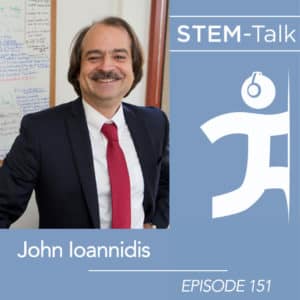
Here, John makes his second appearance on STEM-Talk to discuss his extensive research into the pandemic. Episode 151 is available now on our podcast page, as well as in popular podcast apps and on YouTube.
John talks about his most recent peer-reviewed paper that looked at the age-stratified infection fatality rate of COVID-19 in the non-elderly population.
The study found that the pre-vaccination fatality rate for those infected may have been as low as 0.03 percent for people under 60 years old, and 0.07 percent for people under 70, far below the World Health Organization’s prediction of a 3.4 percent fatality rate.
Over the past two decades, John’s research has earned him a global reputation as a consummate physician and researcher, which contributed to The Atlantic describing him in 2010 as one of the most influential scientists alive. He is a professor of medicine, epidemiology and population health as well as a statistician and professor of biomedical data science at Stanford University.
In today’s episode, John:
- Shares what led him to study infectious diseases.
- Walks us through his most recent paper, published in January 2023 on COVID-19 mortality rates.
- Talks about the role that obesity rates may have had on mortality rates across the globe.
- Describes as the U.S. government’s response to the pandemic and the importance of collecting reliable data in the future to guide disease modelers and governments before they make decisions on significant policies, such as lockdowns.
- Discusses how he underestimated the power that politics and the media can have on science.
- Discusses the erosion of public trust in institutions and the media and what might be done to re-establish that trust.
IHMC is a not-for-profit research institute of the Florida University System where researchers pioneer science and technology aimed at leveraging and extending human capabilities. IHMC researchers and staff collaborate extensively with the government, industry and academia to help develop breakthrough technologies. IHMC research partners have included: DARPA, the National Science Foundation, NASA, Army, Navy, Air Force, National Institutes of Health, IBM, Microsoft, Honda, Boeing, Lockheed, and many others.
Triumph Gulf Coast funding supports IHMC purchase of cutting-edge gene sequencer
IHMC is purchasing a new NovaSeq X Plus genetic sequencing device that will help elevate the Institute’s footprint as a regional hub of excellence in human performance research.
IHMC will be among the first labs in the country to have the newest version of this device, which allows for next-generation sequencing capacity to better understand genetics, genomics, epigenetics, and transcriptomics.

IHMC is purchasing a NovaSeq X genetic sequencer to support its human performance research. Credit: Special to IHMC.
“The information contained in our genes and how they are activated and regulated is extremely important in understanding risks of disease, along with differences between individuals and the responses of each person to a treatment or exposure to stress,” says Dr. Marcas Bamman, Senior Research Scientist and Director of Healthspan, Resilience, and Performance Research at IHMC. “Scientific advances resulting from such a capability are truly game-changing because the information gained will help us optimize approaches to healthspan, resilience, and ultimately human performance.”
The ability to perform sequencing analysis of both RNA and DNA is foundational in biomedical sciences, however, the tools to perform this analysis typically are found at major biotechnology research hubs or in private industry locations.
“With IHMC being among the first institutions to acquire the device, we will not only be among the leaders in the field; we also will be in a position to offer this advanced tool in collaboration with other scientific partners,” Bamman says.
The ability to conduct this level of research in-house will also reduce IHMC’s dependency on other labs, and the associated subcontracting of awarded funding.
“This places IHMC in much higher demand for collaboration on future funded research programs,” said founder and CEO Ken Ford. “We are all very excited to receive this new device and begin tapping into its capabilities.”
Ryan Tilley, IHMC’s director of strategic program execution and innovation, said the $1.5 million purchase is supported by funding from Triumph Gulf Coast, a nonprofit corporation created to manage the funds from the settlement of the BP Deepwater Horizon 2010 oil spill disaster.
“Triumph’s mission is to use the proceeds of the BP settlement to support projects that provide a transformational impact to workforce and entrepreneurial efforts, as well as expanding and diversifying the economy of our region,” Tilley said.
Creating a biotechnology and human performance research hub in Northwest Florida has profound benefits not only to the economic health of the region, but also to the intellectual capital that can be nurtured and expanded here because of those investments.
“We are proud that Triumph sees IHMC as a leader in this effort and we are grateful for their support,” Tilley said.
Illumina, the company that developed the device, delivered the first of these sequencers to the Broad Institute at Massachusetts Institute of Technology and Harvard University in February of 2023. The company plans to ship more than 300 instruments in total this year, according to the company.
IHMC is a not-for-profit research institute of the Florida University System where researchers pioneer science and technology aimed at leveraging and extending human capabilities. IHMC researchers and staff collaborate extensively with the government, industry and academia to help develop breakthrough technologies. IHMC research partners have included: DARPA, the National Science Foundation, NASA, Army, Navy, Air Force, National Institutes of Health, IBM, Microsoft, Honda, Boeing, Lockheed, and many others.
WATCH: 2023 IHMC Robotics Open House
Everyone likes company — and IHMC is no exception.
More than 350 people came through our doors for 2023’s Robotics Open House. The family-friendly event allowed IHMC researchers to share some of what they do with students and families.
We had a great time showcasing our work in robotics, virtual reality experiences, human performance research projects, data visualization, and more. If you couldn’t be there, here’s a little of what you missed.
For students to get an IHMC experience, we have two upcoming opportunities: Science Saturday on April 22 for students in grades 3-6, and summer Robotics Camp June 5-8 in Pensacola. Sign up today.
IHMC researchers to help build testing environment to improve operator awareness.
IHMC received nearly $4 million in grant funding as a subaward to SRI International’s “PROTEUS: Prototype Testing environment for User Situation awareness.”
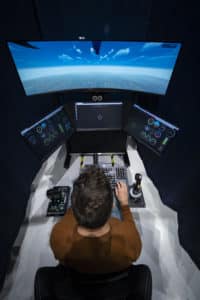
PROTEUS is a rapidly reconfigurable human-machine interface (HMI) testing environment for early and cost-effective testing of human machine prototypes, specifically those designed to improve operator situation awareness and support agile adaptation to off-nominal situations.
The PROTEUS Team is a project the Defense Advanced Research Projects Agency and is a collaboration between SRI International (prime, headquartered in Menlo Park, CA), IHMC, and SkillMil, Inc., (Menlo Park, CA). IHMC’s effort is led by Senior Research Scientist Dr. Anil Raj.
PROTEUS will develop and provide a set of plug-and-play, low-cost hardware configurations to support ecologically realistic environments across operational domains (e.g., air, maritime, space).
The PROTEUS team will create a testbed design for conducting human research participant experiments, and execute protocols designed to deliver statistically significant operator situation awareness and performance assessment results in less than one week per iteration (“Evaluation Events”). Raj is responsible for conducting the Evaluation Events at IHMC.
As it stands, creating a testbed for a new scenario that could sustain more than 30 in-person and 90 virtual participants typically takes weeks or months. With technologies developed under the PROTEUS project, the team believes they can cut that time to a few days per new scenario.
Increasing the number of design and testing iterations an HMI can go through before deployment has a major influence on its effectiveness. Making the iteration process faster and more efficient should pay dividends in the end.
The PROTEUS concept includes
· On-site multimodal, rapidly reconfigurable fixed-base simulators as well as web-hosted “virtual” testbeds that enable remote users to participate in HMI evaluations.
· Visual editors that enable collaborative development.
· Build-time capabilities will include automated code generators to construct testbed-ready “instrumented” HMI prototypes used for functional and stress testing ahead of evaluation events.
· Modeling technology that requires minimal calibration and extends diagnostic information for emotional and physiological state assessment (drowsiness, frustration).
· Off nominal events and situation awareness assessment queries will be embedded in each scenario to test HMI support of graceful adaptation and impact on situation awareness.
· PROTEUS will track and display operator attention dynamics using gaze-trackers (on-site testbeds) and webcams (remote), as well as task performance and situation awareness metrics in real time.
The grant runs through 2025.
This story is approved for public release by DARPA, with unlimited distribution.
IHMC is a not-for-profit research institute of the Florida University System where researchers pioneer science and technology aimed at leveraging and extending human capabilities. IHMC researchers and staff collaborate extensively with the government, industry and academia to help develop breakthrough technologies. IHMC research partners have included: DARPA, the National Science Foundation, NASA, Army, Navy, Air Force, National Institutes of Health, IBM, Microsoft, Honda, Boeing, Lockheed, and many others.


